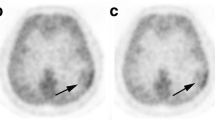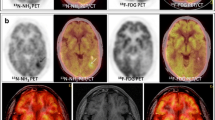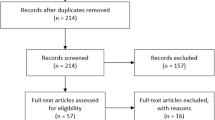Abstract
Purpose
18F-fluorodeoxyglucose (FDG) and 11C-methionine (MET) PET imaging studies allow the investigation of metabolism and amino acid transport in brain tumours. Their (relative) usefulness and prognostic value in suspected recurrence or progression of primary brain tumours after previous therapy is an issue of debate. The aim of this study was to compare directly both radioligands in this setting.
Methods
Cerebral uptake of FDG and MET was determined sequentially on the same day in 30 patients (21 males, nine females; age 40.4±15.6 years), on average 4.0 years (range 0.1–18) after therapy for a primary brain tumour (23 grade II–IV astrocytomas, four oligodendrogliomas and three mixed oligo-astrocytomas). Images were acquired on a Siemens HR+ dedicated PET camera. Two observers scored FDG and MET scans independently. Semi-quantitative indices defined by the tumour (maximum)-to-background ratio were calculated based on manual ROI delineation and by using MET ROIs for FDG after automated co-registration. Patient follow-up was conducted until the last contact with inconspicuous clinical findings (average 41 months, range 12–62 months after PET) [(n=10)] or until death (n=20).
Results
Overall median survival was 15.0 months. MET showed pathologically increased uptake in 28/30 scans, and FDG in 17/30. The inter-observer agreement was 100% for MET and 73% for FDG. Using Kaplan-Meier survival analysis, significant differences were found for both FDG (cut-off 0.8, log-rank p=0.007) and MET (cut-off 2.2, log-rank p=0.014). The combination of FDG and MET information resulted in the highest prognostic accuracy (p=0.003), while MET alone was the best prognostic predictor in the subgroup of patients with primary astrocytoma (n=23).
Conclusion
FDG and MET PET studies provide complementary prognostic information in patients with suspected brain tumour recurrence or progression after primary therapy. MET is considered the single agent of choice in the evaluation of these patients because of its sensitivity and clearer delineation of the suspected recurrence.







Similar content being viewed by others
References
Del Sole A, Falini A, Ravasi L, et al. Anatomical and biochemical investigation of primary brain tumours. Eur J Nucl Med 2001;28:1851–72.
Benard F, Romsa J, Hustinx R. Imaging gliomas with positron emission tomography and single-photon emission computed tomography. Semin Nucl Med 2003;33:148–62.
Langleben DD, Segall GM. PET in differentiation of recurrent brain tumor from radiation injury. J Nucl Med 2000;41:1861–7.
Barker FG, Chang SM, Valk PE, Pounds TR, Prados MD. 18-Fluorodeoxyglucose uptake and survival of patients with suspected recurrent malignant glioma. Cancer 1997;79:115–26.
Chao ST, Suh JH, Raja S, Lee SY, Barnett G. The sensitivity and specificity of FDG PET in distinguishing recurrent brain tumor from radionecrosis in patients treated with stereotactic radiosurgery. Int J Cancer 2001;96:191–7.
Di Chiro G, Oldfield E, Wright DC, et al. Cerebral necrosis after radiotherapy and/or intraarterial chemotherapy for brain tumors: PET and neuropathologic studies. Am J Roentgenol 1988;150:189–97.
Mirzaei S, Knoll P, Kohn H. Diagnosis of recurrent astrocytoma with fludeoxyglucose F18 PET scanning. N Engl J Med 2001;344:2030–1.
Goldman S, Levivier M, Pirotte B, et al. Regional glucose metabolism and histopathology of gliomas. A study based on positron emission tomography-guided stereotactic biopsy. Cancer 1996;78:1098–106.
Ribom D, Eriksson A, Hartman M, et al. Positron emission tomography 11C-methionine and survival in patients with low-grade gliomas. Cancer 2001;92:1541–49.
Brock CS, Young H, O’Reilly SM, et al. Early evaluation of tumour metabolic response using [18F]fluorodeoxyglucose and positron emission tomography: a pilot study following the phase II chemotherapy schedule for temozolomide in recurrent high-grade gliomas. Br J Cancer 2000;82:608–15.
Jager PL, Vaalburg W, Pruim J, de Vries EG, Langen KJ, Piers DA. Radiolabeled amino acids: basic aspects and clinical applications in oncology. J Nucl Med 2001;42:432–45.
Ribom D, Engler H, Blomquist E, Smits A. Potential significance of 11C-methionine PET as a marker for the radiosensitivity of low-grade gliomas. Eur J Nucl Med Mol Imaging 2002;29:632–40.
Kuwert T, Woesler B, Morgenroth C, et al. Diagnosis of recurrent glioma with SPECT and iodine-123-alpha-methyl tyrosine. J Nucl Med 1998;39:23–7.
Voges J, Herholz K, Holzer T, et al. 11C-methionine and 18F-2-fluorodeoxyglucose positron emission tomography: a tool for diagnosis of cerebral glioma and monitoring after brachytherapy with 125I seeds. Stereotact Funct Neurosurg 1997;69:129–35.
Weckesser M, Matheja P, Schwarzrock A, et al. Prognostic significance of amino acid transport imaging in patients with brain tumors. Neurosurgery 2002;50:958–64.
De Witte O, Goldberg I, Wikler D, et al. Positron emission tomography with injection of methionine as a prognostic factor in glioma. J Neurosurg 2001;95:746–50.
Pirotte B, Goldman S, Salzberg S, et al. Combined positron emission tomography and magnetic resonance imaging for the planning of stereotactic brain biopsies in children: experience in 9 cases. Pediatr Neurosurg 2003;38:146–55.
Nuutinen J, Sonninen P, Lehikoinen P, et al. Radiotherapy treatment planning and long-term follow-up with [11C]methionine PET in patients with low-grade astrocytoma. Int J Radiat Oncol Biol Phys 2000;48:43–52.
Levivier M, Wikler D Jr, Massager N, et al. The integration of metabolic imaging in stereotactic procedures including radiosurgery: a review. J Neurosurg 2002;97:542–50.
Grosu AL, Feldmann H, Dick S, et al. Implications of IMT-SPECT for postoperative radiotherapy planning in patients with gliomas. Int J Radiat Oncol Biol Phys 2002;54:842–54.
Rajasekar D, Datta NR, Gupta RK, Pradhan PK, Ayyagari S. Multimodality image fusion in dose escalation studies of brain tumors. J Appl Clin Med Phys 2003;4:8–16.
Riemann B, Papke K, Hoess N, et al. Noninvasive grading of untreated gliomas: a comparative study of MR imaging and 3-(iodine 123)-l-alpha-methyltyrosine SPECT. Radiology 2002;225:567–74.
Schmidt D, Gottwald U, Langen KJ, et al. 3-[123I]iodo-alpha-methyl-l-tyrosine uptake in cerebral gliomas: relationship to histological grading and prognosis. Eur J Nucl Med 2001;28:855–61.
Samnick S, Bader JB, Hellwig D, et al. Clinical value of iodine-123-alpha-methyl-l-tyrosine single-photon emission tomography in the differential diagnosis of recurrent brain tumor in patients pretreated for glioma at follow-up. J Clin Oncol 2002;20:396–404.
Sonoda Y, Kumabe T, Takahashi T, Shirane R, Yoshimoto T. Clinical usefulness of 11C-MET PET and 201T1 SPECT for differentiation of recurrent glioma from radiation necrosis. Neurol Med Chir (Tokyo) 1998;38:342–7.
Ogawa T, Kanno I, Shishido F, et al. Clinical value of PET with 18F-fluorodeoxyglucose and l-methyl-11C-methionine for diagnosis of recurrent brain tumor and radiation injury. Acta Radiol 1991;32:197–202.
Derlon JM, Chapon F, Noel MH, et al. Non-invasive grading of oligodendrogliomas: correlation between in vivo metabolic pattern and histopathology. Eur J Nucl Med 2000;27:778–87.
Kaschten B, Stevenaert A, Sadzot B, et al. Preoperative evaluation of 54 gliomas by PET with fluorine-18-fluorodeoxyglucose and/or carbon-11-methionine. J Nucl Med 1998;39:778–85.
Utriainen M, Metsahonkala L, Salmi TT, et al. Metabolic characterization of childhood brain tumors: comparison of 18F-fluorodeoxyglucose and 11C-methionine positron emission tomography. Cancer 2002;95:1376–86.
Ishizu K, Nishizawa S, Yonekura Y, et al. Effects of hyperglycemia on FDG uptake in human brain and glioma. J Nucl Med 1994;35:1104–9.
Maes F, Collignon A, Vandermeulen D, Marchal G, Suetens P. Multimodality image registration by maximization of mutual information. IEEE Trans Med Imaging 1997;16:187–98.
Meyer PT, Schreckenberger M, Spetzger U, et al. Comparison of visual and ROI-based brain tumour grading using 18F-FDG PET: ROC analyses. Eur J Nucl Med 2001;28:165–74.
Kracht LW, Friese M, Herholz K, et al. Methyl-[11C]-l-methionine uptake as measured by positron emission tomography correlates to microvessel density in patients with glioma. Eur J Nucl Med Mol Imaging 2003;30:868–73.
Kim EE, Chung SK, Haynie TP, et al. Differentiation of residual or recurrent tumors from post-treatment changes with F-18 FDG PET. Radiographics 1992;12:269–79.
Kubota R, Kubota K, Yamada S, et al. Methionine uptake by tumor tissue: a microautoradiographic comparison with FDG. J Nucl Med 1995;36:484–92.
Langen KJ, Ziemons K, Kiwit JC, et al. 3-[123I]iodo-alpha-methyltyrosine and [methyl-11C]-l-methionine uptake in cerebral gliomas: a comparative study using SPECT and PET. J Nucl Med 1997;38:517–22.
Mineura K, Sasajima T, Kowada M, Ogawa T, Hatazawa J, Uemura K. Indications for differential diagnosis of nontumor central nervous system diseases from tumors. A positron emission tomography study. J Neuroimaging 1997;7:8–15.
Tsuyuguchi N, Sunada I, Iwai Y, et al. Methionine positron emission tomography of recurrent metastatic brain tumor and radiation necrosis after stereotactic radiosurgery: is a differential diagnosis possible? J Neurosurg 2003;98:1056–64.
Goldman S, Levivier M, Pirotte B, et al. Regional methionine and glucose uptake in high-grade gliomas: a comparative study on PET-guided stereotactic biopsy. J Nucl Med 1997;38:1459–62.
Weber W, Bartenstein P, Gross MW, et al. Fluorine-18-FDG PET and iodine-123-IMT SPECT in the evaluation of brain tumors. J Nucl Med 1997;38:802–8.
Wester HJ, Herz M, Weber W, et al. Synthesis and radiopharmacology of O-(2-[18F]fluoroethyl)-l-tyrosine for tumor imaging. J Nucl Med 1999;40:205–12.
Becherer A, Karanikas G, Szabo M, et al. Brain tumour imaging with PET: a comparison between [18F]fluorodopa and [11C]methionine. Eur J Nucl Med Mol Imaging 2003;30:1561–7.
Tzika AA, Astrakas LG, Zarifi MK, et al. Multiparametric MR assessment of pediatric brain tumors. Neuroradiology 2003;45:1–10.
Thompson TP, Lunsford LD, Kondziolka D. Distinguishing recurrent tumor and radiation necrosis with positron emission tomography versus stereotactic biopsy. Stereotact Funct Neurosurg 1999;73:9–14.
Dropcho EJ, Soong SJ. The prognostic impact of prior low-grade histology in patients with anaplastic gliomas: a case-control study. Neurology 1996;47:684–90.
Acknowledgements
The authors wish to thank Mrs M. Bex for the preparation of the tracers and Drs. F. Braga, A. Kolindau and P. Supatporn for their contribution in performing a preliminary review of the data. One of the authors (K.V.L.) is supported by a Clinical Research Mandate by the local University Hospital.
Author information
Authors and Affiliations
Corresponding author
Additional information
The first two authors contributed equally to this paper
Rights and permissions
About this article
Cite this article
Van Laere, K., Ceyssens, S., Van Calenbergh, F. et al. Direct comparison of 18F-FDG and 11C-methionine PET in suspected recurrence of glioma: sensitivity, inter-observer variability and prognostic value. Eur J Nucl Med Mol Imaging 32, 39–51 (2005). https://doi.org/10.1007/s00259-004-1564-3
Received:
Accepted:
Published:
Issue Date:
DOI: https://doi.org/10.1007/s00259-004-1564-3




